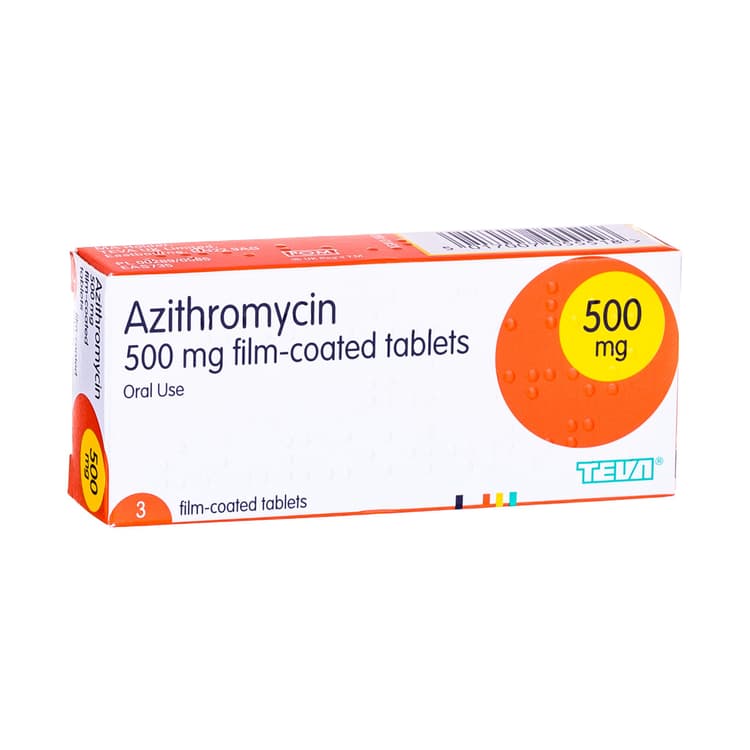- Home
- Sexual Health
- Chlamydia Treatment
- Azithromycin
Azithromycin

Images for illustrative purposes only
Start Your Expert Consultation
Chlamydia is a sexually transmitted disease caused by bacteria. Azithromycin works by killing the bacteria, as it contains macrolide antibiotics.
- Effective antibiotic
- Stops the growth of bacteria
- Clears Chlamydia
- Genuine medication
- All drugs sourced in the UK
More information
A Doctor's Overview
 | GP and surgeon, Dr Shane Charles (MBBS, MRCS, PgDip SEM) provides a simple explanation of the medication below: 'Azithromycin is an antibiotic used to treat several bacterial infections. '. If you think this is a treatment that can help you, start an online consultation now for a registered prescriber to review. If treatment is deemed suitable, they can prescribe it, and we can deliver it to you from the comfort of your own home with a range of convenient delivery and payment options for you to choose from. If you have any questions about a medication, you should always consult your doctor with any questions prior to starting treatment, to ensure that it is safe and suitable for you. |
Buying Azithromycin Online in the UK
How do I buy Azithromycin online?
You can safely buy Azithromycin online at UK Meds. Here's how it works:
- Online Consultation: You will need to complete an online consultation with a registered independent prescriber.
- Personalised Assessment: The prescriber will review your medical history and symptoms to determine if Azithromycin is the right treatment for your condition.
- Secure Delivery: If approved, your medication will be supplied and delivered directly to your door.
This process ensures that Azithromycin is prescribed appropriately and safely. Always follow medical advice and use prescription medications responsibly.
Azithromycin - Summary
| Active ingredient(s) | Azithromycin |
| Prescribed for: | Azithromycin is an antibiotic used in the treatment of genital infections like chlamydia and ureaplasma (when combined with cefixime) |
| Available form: | Oral tablet |
| Available dosage(s) | 500 mg | Usage | Take 2 tablets together as a single dose |
| Drug type | Macrolide antibiotics |
| When breastfeeding | Side effects not expected. Consult your doctor |
| When pregnant | Not expected. Consult your doctor |
Azithromycin - Key Information
What is Azithromycin?
Azithromycin 500mg
Azithromycin is an antibiotic commonly used to treat bacterial infections, including Chlamydia, a sexually transmitted infection. It belongs to a group of antibiotics known as macrolides and is effective in targeting and eliminating the bacteria that cause these infections.
How does Azithromycin work?
Chlamydia is caused by bacteria. Azithromycin works by killing these bacteria, helping to stop the infection. Its macrolide antibiotics specifically target the bacteria, preventing them from multiplying and spreading further.
What are the benefits of taking Azithromycin?
- Quick and Effective Treatment: Azithromycin provides a simple and fast way to treat Chlamydia.
- Prevents Further Health Issues: While Chlamydia often has no symptoms, untreated infections can lead to complications like inflammation and, in severe cases, infertility.
- Reduces Spread: By treating the infection, Azithromycin prevents it from being passed on to others.
It’s important to get checked regularly and seek prompt treatment for sexually transmitted infections to maintain your health and prevent complications.
What do Azithromycin users have to say?
Azithromycin Reviews
Read first hand what other patients think about Azithromycin and it's impact on their lives on the large selection of Azithromycin reviews describing their experiences with the medication at Drugs.com and Web MD and forum discussions on Patient.
It is important to note that people may have different experiences when they use Azithromycin. If someone states that their medication did not work as they had hoped, it does not mean that it will not work for you. If you believe that it is the right medication for you then the best thing to do is to consult your doctor or healthcare professional, and judge the medication based on your own experiences if they recommend it as a treatment. Before starting a medication you should always consult with your healthcare provider first to ensure that it is safe and suitable for your individual needs.
Patient Information Leaflet
For more information on the prescription medication patients should refer to the Azithromycin patient information leaflet.
Usage
How Should I Take Azithromycin?
- Dosage: Take azithromycin once a day at the same time each day.
- Swallowing: Tablets and capsules should be swallowed whole with water. Capsules should be taken at least 1 hour before food or 2 hours after eating. Tablets or liquid forms can be taken with or without food.
- Liquid Form: Azithromycin liquid is available for children or adults who find swallowing tablets difficult. It may have a bitter aftertaste, so giving children a drink of fruit juice afterward can help.
- Measuring Liquid Medicine: Your pharmacist will usually prepare the liquid medicine and provide a syringe or spoon for accurate measurement. If you don't have one, ask your pharmacist. Avoid using kitchen teaspoons as they are not accurate.
- Antacid Interaction: Do not take indigestion remedies 2 hours before or after azithromycin, as they can interfere with the medicine.
Azithromycin is safe and effective when taken as directed, so follow your doctor’s advice and the instructions provided with your medication.
Dosage
What is the typical dosage of Azithromycin?
Active Ingredient: Azithromycin tablets or capsules contain azithromycin monohydrate, available in doses of 250mg or 500mg. Your doctor will prescribe the right dose based on your condition.
Dosage for Chlamydia:
- Standard Dose: Take 1000mg as a single dose for one day only.
Dosage for Other Conditions:
- Azithromycin may be taken over 3 or 5 days, depending on your doctor’s instructions.
What If I Miss a Dose?
- Take it as soon as you remember.
- If it’s almost time for your next dose and you’re taking it for multiple days, skip the missed dose—don’t double up.
What If I Take Too Much?
- Symptoms: Taking more than recommended may cause side effects such as hearing loss (usually reversible), nausea, or diarrhoea.
- What to Do: Contact a doctor or pharmacist immediately if you’ve taken too much.
Follow your doctor’s guidance carefully and read the patient leaflet for more details about your prescription.
Side Effects
What side effects can Azithromycin have?
Azithromycin, like all medications, may cause side effects. These can range from common and mild to rare and serious. Always consult a doctor if you are concerned about any symptoms.
Common Side Effects
These side effects occur in more than 1 in 100 people. Speak to your doctor or pharmacist if they bother you or don’t go away:
- Feeling sick (nausea).
- Diarrhoea or vomiting (being sick).
- Loss of appetite.
- Headaches.
- Feeling dizzy or tired.
- Changes in your sense of taste.
Uncommon (Serious) Side Effects
Serious side effects are rare and happen in less than 1 in 1,000 people. Seek medical help immediately if you experience:
- Chest pain or a fast or irregular heartbeat.
- Yellowing of the skin or eyes (jaundice).
- Ringing in your ears or temporary hearing loss.
- Severe dizziness or feeling like you might fall (vertigo).
- Sharp or severe pain in your back or stomach.
- Diarrhoea with blood or mucus.
Severe Diarrhoea Warning
If you have severe diarrhoea (even without blood or mucus) lasting more than four days, contact a doctor. This could indicate a serious condition called colitis, which requires immediate treatment.
Always follow your doctor’s instructions and report any concerning symptoms promptly.
A doctor's overview of the side effects of this medication and how to manage them:
 | NHS Specialty Doctor in Sexual and Reproductive Health and Forensic Medicine, Samantha Miller, provides a simple explanation of the common side effects of the medication and how you can manage them: The most common side effects of Azithromycin are digestive upset (including loose stools, abdominal pain, feeling sick (nausea), wind (flatulence), and stomach cramps. To help alleviate these side effects, take Azithromycin either 1 hour before a meal or 2 hours after a meal. Stay well hydrated and avoid consuming spicy or rich foods. Other common side effects include reduced appetite, headache, dizziness, pins and needles or numbness, changes in taste, alterations in vision or hearing, nausea, skin rash or itch, joint pain, fatigue, and weakness. Side effects are usually temporary and resolve after completing your treatment course. If you get any side effects, talk to your doctor or pharmacist. |
Warnings & Precautions
What precautions should I take when taking Azithromycin tablets?
What precautions should I take when using Azithromycin tablets?
Azithromycin and Alcohol
Avoid alcohol while taking Azithromycin, as combining the two can increase the risk of side effects. This medication may also cause dizziness, so avoid driving or operating machinery until you know how it affects you.
Azithromycin During Pregnancy
- Azithromycin is generally safe to take during pregnancy if needed to treat an infection.
- However, your doctor might recommend other antibiotics depending on your infection type.
- Only take Azithromycin during pregnancy if the benefits outweigh any possible risks.
For more details about Azithromycin during pregnancy, visit the Best Use of Medicines in Pregnancy (BUMPS) website.
Azithromycin While Breastfeeding
- If your doctor confirms your baby is healthy, you can safely take Azithromycin while breastfeeding.
- Azithromycin passes into breast milk in small amounts and is not known to cause side effects in breastfed babies.
- Contact your doctor or health visitor if your baby shows any of the following:
- Trouble feeding or an upset stomach.
- A rash or oral thrush (fungal infection in the mouth).
- Any other concerning symptoms.
Azithromycin and Fertility
- There is no evidence to suggest Azithromycin affects fertility in men or women.
- Inform your doctor if you are trying to conceive, pregnant, or breastfeeding.
Precautions for Pre-Existing Medical Conditions
Tell your doctor if you have any of the following conditions before taking Azithromycin:
- Severe kidney or liver issues.
- Severe heart problems.
- Low potassium or magnesium levels.
- Signs of another infection.
- Muscle weakness conditions.
- Mental health disorders.
Interactions with Other Medications
Azithromycin may interact with certain medications. Inform your doctor if you take any of the following:
- Antacids for heartburn or indigestion.
- Statins for lowering cholesterol.
- Blood thinners.
- Migraine medications.
- HIV treatments.
- Organ rejection prevention medicines.
- Certain heart medications.
Additional Information
- Always read the patient information leaflet for a full list of precautions.
- If you’re unsure about anything, ask your healthcare provider for guidance.
Azithromycin FAQs
Is Azithromycin a treatment for Chlamydia?
Yes, Azithromycin is one of the two common medications used to treat Chlamydia, alongside Doxycycline. Your doctor will choose the most suitable option based on your individual circumstances.
- How It Works: Azithromycin typically takes up to 7 days to clear the infection. During this period, it’s important to avoid sexual activity (including oral sex) to prevent spreading the infection (NHS, 2021).
Is azithromycin an antibiotic?
Yes, azithromycin is an antibiotic. It is commonly used to treat a variety of infections, including:
- Chest infections, such as pneumonia.
- Ear, nose, and throat infections, like sinus infections (sinusitis).
Azithromycin is effective in fighting bacterial infections, helping to reduce symptoms and prevent complications. Always take it as prescribed by your doctor.
Why Is Azithromycin Prescribed for Only 3 Days?
Azithromycin is often prescribed for 3 days because it is highly effective in treating mild to moderate infections quickly. In some cases, the course may be extended to 3 to 10 days, depending on the severity of the infection and your doctor’s recommendation.
- The standard dose is usually 500mg once a day.
- Azithromycin is biologically effective, meaning it works faster than many other antibiotics, such as amoxiclav (amoxicillin and potassium clavulanate).
Its ability to fight infections efficiently makes it a trusted option for short treatment durations, reducing the need for longer courses while maintaining effectiveness. Always follow your doctor’s advice regarding dosage and duration.
Is Azithromycin available over the counter?
No, Azithromycin is a prescription-only medication and cannot be purchased over the counter.
- How to Access It: You can obtain Azithromycin through an online prescription service, such as UK Meds. Following a clinical consultation with a registered independent prescriber, they will determine if it is appropriate for your condition.
- Important Note: All medication requests are reviewed carefully, and prescriptions are issued only when deemed necessary by a healthcare professional.
For more guidance, speak to your GP or consult an online prescriber for support.
Sources:
Learn more with UK Meds support resources for Azithromycin:
- What Is Azithromycin? - Learn about Azithromycin, a commonly used antibiotic to treat bacterial infections.
Here to help you
Our Customer Service is available Monday to Friday 9am - 5pm. If you need urgent assistance, do not use this service. Call 111, or in an emergency call 999. Visit our help section


